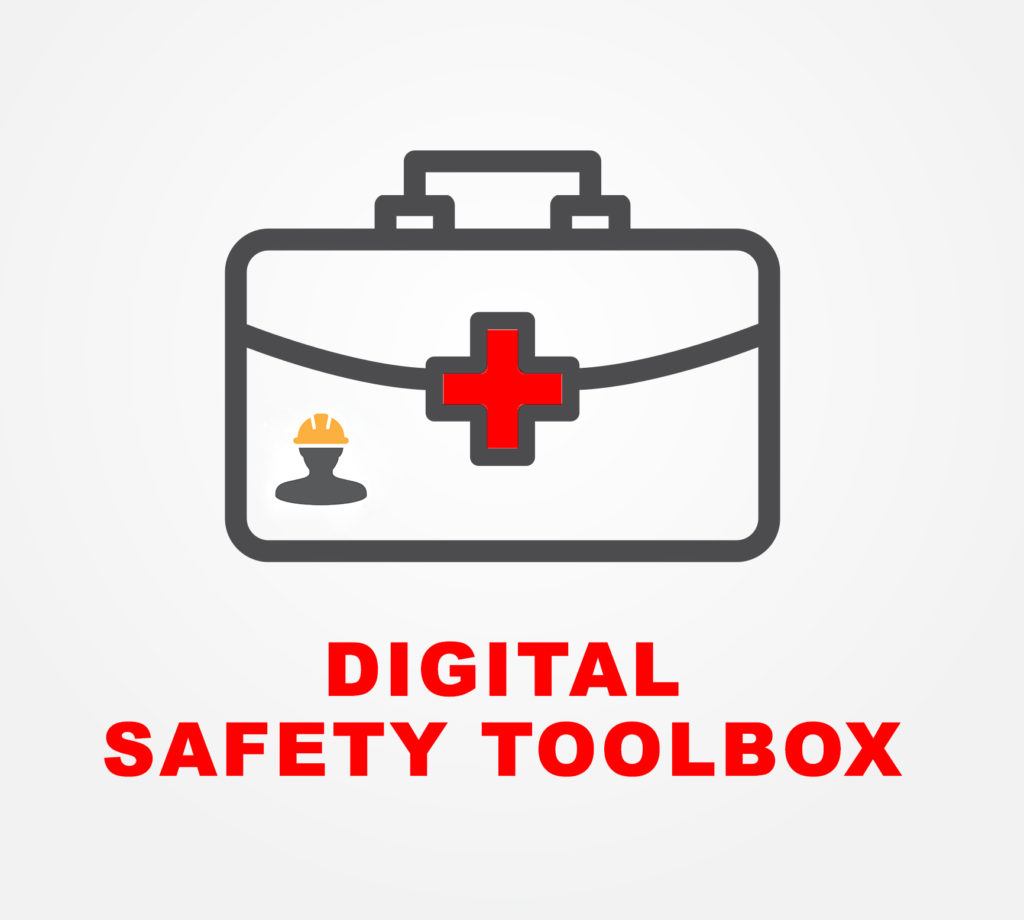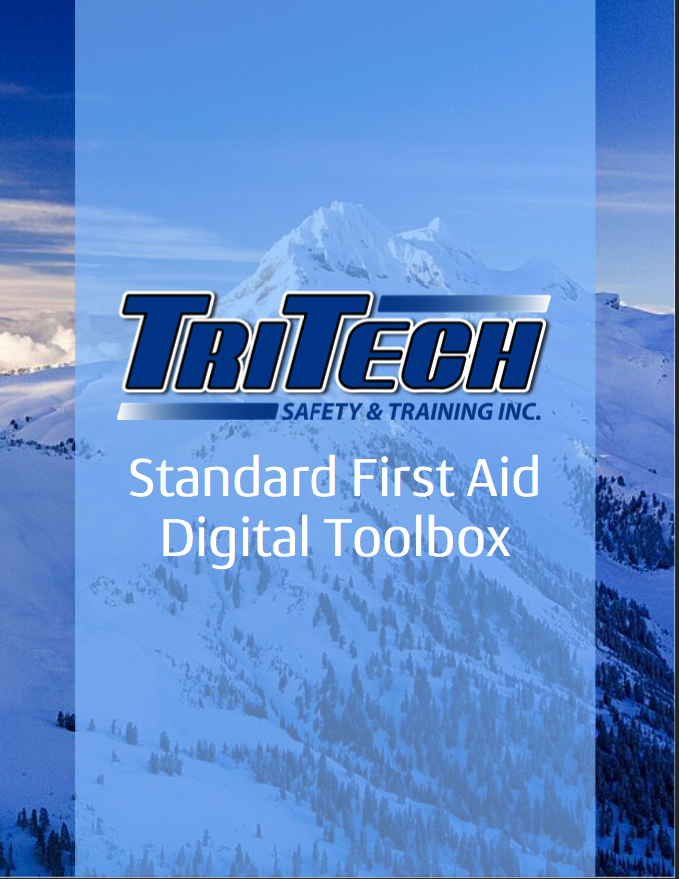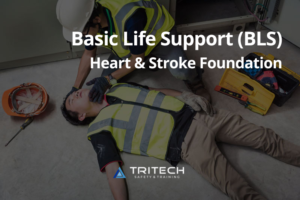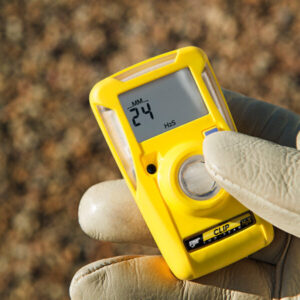Free TriTech Standard First-Aid Digital-Toolbox Guide
About this Guide
This Standard First Aid guide has been developed to assist with the unique needs of your small business in regards to occupational health and safety obligations. It will provide you with the practical tools and information necessary to ensure proper first-aid. The toolbox provided is advisory in nature, informational in content, and is intended to assist employers in providing a safe and healthy workplace.
The Occupational Health and Safety Act requires employers to comply with a set of health and safety standards and regulations. This guide outlines the standard first aid and emergency care that should be provided for injuries while waiting for emergency medical treatment to become available.
In your workplace, the first-aid provider should be someone who is trained in the delivery of initial medical emergency procedures, using a limited amount of equipment to perform these assessments and interventions.
The focus of this guide is to help you recognize situations where first aid is required and to provide you with the information needed to perform care until emergency medical service (EMS) personnel arrive.
Our Free TriTech Standard First-Aid Digital-Toolbox Guide is just one part of a comprehensive safety and health management program. Its purpose is to present a summary of the basic elements of a standard first-aid program including:
- Determining proper scene management and control
- Learning how to recognize life-threatening injuries
- Designing and implementing a first-aid program that covers such essential intervention activities as:
- Artificial Respiration (CPR) & Airway Obstructions
- Electrical Shock
- Life-Threatening Bleeding
- Bone and Joint Injuries
- Head, Neck, and Spinal Injuries
Chapter 1: Scene Management
The best advice in planning for an emergency is to prepare for the unexpected. Plan for the worst-case scenarios, so that your response plans are sufficient in scope for any situation. To be prepared for emergency situations that require first aid, your business should have already:
- Identified the potential hazards that could result in injury or illness,
- Determined the likelihood and severity (risk),
- Prepared the appropriate first aid facilities and training,
- Trained for treatment.
By knowing the hazards as well as the known occurrences of injuries, illnesses, and incidents, your first aid provider can be better prepared for determining if an injury is life threatening and requires immediate emergency aid.
Evaluate the Scene
Once on the scene and before approaching the victim, your first-aid provider should evaluate the potential dangers. Check for:
- Electrical Lines,
- Hazardous Materials
- Vehicular Traffic
- Machinery
- Fire
- Chemical Spills
First-Aid Kit
The following list outlines the minimally acceptable number and type of first-aid supplies that should be on-hand and provided in the first-aid kit. This kit is appropriate for small worksites of two to three employees. If you are a larger corporation or farther away from medical aid, larger first-aid kits should be provided at the work site.
-
The following list outlines the minimally acceptable number and type of first-aid supplies that should be on-hand and provided in the first-aid kit.
SCHEDULE 3 First Aid Equipment and Supplies
1. A No. 1 Kit consists of the following:
(a) 10 antiseptic cleansing towelettes, individually packaged;
(b) 25 sterile adhesive dressings, individually packaged;
(c) 10 10 cm x 10 cm sterile gauze pads, individually packaged;
(d) 2 10 cm x 10cm sterile compress dressings, with ties, individually packaged;
(e) 2 15cm x15 cm sterile compress dressings, with ties, individually packaged;
(f) 2 conform gauze bandages — 7.5 cm;
(g) 3 cotton triangular bandages;
(h) 5 safety pins — assorted sizes;
(i) 1 pair of scissors;
(j) 1 pair of tweezers;
(k) 1 25 mm x 4.5 m of adhesive tape;
(l) 1 crepe tension bandage — 75 mm;
(m) 1 artificial resuscitation barrier device with a one-way valve;
(n) 4 pairs of disposable surgical gloves;
(o) 1 first aid instruction manual (condensed);
(p) 1 inventory of kit contents;
(q) 1 waterproof waste bag.SCHEDULE 6 First Aid Requirements
1. Low Hazard
(a) 2-10 workers
(b) Close worksite (to medical care) – 20 min
(c) No. 1 kit
(2) Medium hazard
(a) 2-9 workers
(b) Close worksite – 20 min
(c) No. 1 kit
(d) 1 Emergency First Aider
Chapter 2: Recognizing Life-Threatening Injuries
Sudden injuries, some of which may be life-threatening, can occur at work. If you are a first-aid provider, it is your responsibility to care for the injured—if no infirmary, clinic, or hospital is on the scene or near to the workplace—until emergency personnel arrives.
At a minimum, first-aid responders at your workplace should have an Emergency First Aid Certification or its equivalent. If you are a higher-risk workplace, you may be required to have a first aid officer who has completed Standard First Aid.
There are two steps to recognizing life-threatening injuries.
1.) Check the Level of Response
When you reach the victim, first check to see if they are conscious:
- Call out to the victim and ask if they can open their eyes or hear you.
- Squeeze the victim’s shoulder and ask them to squeeze your hand.
- Do not move the victim unless there is a hazard that could cause further injury.
2.) Call for Help—Dial EMS/9-1-1
You should call emergency services immediately.
- If you cannot call, ask someone with you to call for help while you work with the person.
- If you are alone, stay with the victim and call emergency services yourself.
- Be ready to provide emergency personnel with the appropriate information regarding your location and the nature of the injury/incident.
- Do NOT hang up unless directed.
- Call using a mobile device if possible so that you can be with victim while talking to dispatch.
Other steps that should be taken when someone is injured include:
- Establish a confined space if respiratory protection and specialized training to perform a rescue is required.
- Prioritize care when there are several injured by assessing each victim for responsiveness, airway patency (blockage), breathing, circulation, and medical alert tags.
- Take victim’s history at the scene, including determining the mechanism of injury.
- Perform a logical head-to-toe check for injuries.
- Continuously monitor the victim.
Chapter 3: Artificial Respiration (CPR) & Airway Obstructions
There may be a time when, on the scene at the site of an injury, the person is struggling to breathe. For this reason, all first aid responders are required to complete their CPR Certificate training every 3 years (unless your employer requests you to be certified sooner). Once that training is completed, the following steps should be followed to comply with adult resuscitation and artificial respiration response.
1.) Check the Airway
First, it is important to check the airway of an unresponsive person. To do this:
- Open the person’s mouth and look for obstructions. Avoid tilting the head back.
- If an obstruction is found—solid or liquid—roll the person into recovery position and clear the mouth and airway.
- Check breathing while the person is in recovery position and move to Step 3, to clear the obstruction.
- If no obstruction, leave the person on their back and move to Step 2.
2.) Check for Breathing
Once you have checked the airway, the next step is to determine how well the person is breathing. To do this:
- Open the airway by tilting the head back and lifting the chin. Be careful not to press on the back of the neck.
- Look for the person’s chest to rise or fall with breath.
- Listen for breathing by placing your ear near the person’s face.
- Feel for moving air by placing your cheek near the person’s nose and mouth.
You should look for normal breathing, which is a minimum of two breaths per 10 seconds.
If they’re NOT breathing or breathing abnormally, call EMS/9-1-1 and start performing CPR (Step 5).
If the person is breathing, move them into recovery position (Step 4).
3.) Clearing the Airway
If the person is conscious, the first thing you should do is ask, “are you choking?” If they are unable to respond, treat as a complete airway obstruction. If they can respond, reassure and encourage the person to cough, and call EMS/9-1-1.
Immediately begin First Aid and call, or have someone nearby call, EMS/9-1-1.
There are three methods that may work: back blows, abdominal thrusts, and chest thrusts.
- – Back Blows: Place arm across the chest and have them bend forward. Then proceed to firmly strike 5x between shoulder blades.
- – Abdominal Thrusts: Wrap your arms around the waist with your fist above the belly button and quickly squeeze between 4-5x.
- – Chest Thrusts: Wrap your arms around person’s chest with hand over fist with thumb facing inward. Squeeze the person’s chest 4-5x.
- – Choking while alone: Dial EMS/9-1-1 and get somewhere that you’re easily seen. Attempt to dislodge by quickly leaning over a safe object providing a self-induced abdominal thrust.
If the person choking becomes non-responsive, alert them that EMS is on the way and begin CPR (see step 5)
4.) Recovery Position
Recovery position should be used in two different scenarios: if the person is breathing normally or if the person has an obstruction in their airway that needs to be removed. The steps to placing the person in recovery position are as follows:
Roll the person towards you, to avoid back injury. To do this:
- Place the person’s arm—the one closest to you—at a right angle to their body.
- Bring the person’s farthest knee up with the foot beside the closest leg’s knee.
- Place their arm—furthest from you—diagonally across their chest and place their fingers under their neck.
- – At the same time, place your forearm under their shoulder, and place your other hand on their knee.
- Roll them onto their side towards you and position the top leg at 90 degrees to stabilize them.
While in recovery position, be sure to check the person’s vitals every two minutes to ensure they are still breathing while you wait for emergency personnel.
5.) Performing CPR
CPR certification and training must be re-certified every 3-years by the first aid responder. As a reminder, we’ve provided the basic CPR steps below.
- Place the person on their back on a firm, flat surface.
- Kneel near their upper body so that you are facing them at a 90-degree angle with your knees shoulder-width apart.
- Place your hands, one atop the other, on the person’s sternum—the center of their chest over the bone. Push down 5-6cm depth at a rate of about 100-120 compressions per minute—sing to the beat of the Bee Gees Stayin’ Alive.
- After 30 compressions, open the person’s mouth—with their head tilted back—and breathe into their mouth. Use a face shield or pocket mask for protection.
- Check to see if the chest rose with your breath and repeat for a second breath.
- Continue the cycle of 30 compressions and two breaths until emergency medical personnel or an AED arrives.
6.) Defibrillation
If the person is unresponsive to CPR, you may need to use an AED (Automated External Defibrillator) if it is available at your facility. To use, follow the instructions on the device.
- AED Should always be requested when 9-1-1 is contacted
- AED should always be connected immediately when available
Chapter 4: Electrical Shock
Electric shock can be incredibly dangerous in the workplace. It’s true danger depends on the type of current, how high the voltage is, and how the current traveled through the victim’s body.
In some cases, electrical shock may leave burns but, in other cases, there may be no visible sign of injury. However, it’s important to remember that electric shock can cause internal damage, cardiac arrest, and other injuries.
There are five steps you should follow when administering first aid to a victim of electric shock.
1.) Evaluate the Danger
Before approaching the victim, you need to determine if the area is still dangerous.
– First, when possible, turn off all power sources before approaching.
– For low voltage, turn off the main power
– For high voltage electricity, authorities should turn off power.
– If you cannot turn off the power, keep 25 meters away from the voltage.
– Before approaching, even if power is off, insulate yourself from the ground using books, newspaper, or rubber matting.
– Try to remove cables or wires from the victim using a non-conductive object (wood, rolled up newspaper). Do not use a blanket or towel.
2.) Check for a Response
As soon as you can approach the victim, check them for response to see if they are conscious. Call out to ask if they can open their eyes or hear you. Squeeze their shoulder and ask them to squeeze your hand.
DO NOT move the victim unless there is a hazard that has the potential to cause further injury.
3.) Check for Breathing
The first thing to look for is whether or not the person is breathing. You should follow the steps as outlined in the previous chapter Artificial Respiration (CPR) & Airway Obstructions.
-
-
- – Check the Airway: Open the victim’s mouth and look for obstructions. Avoid tilting the head back. If an obstruction found—solid or liquid—roll the victim into recovery position and clear the mouth an airway. If no obstruction, leave the victim on their back.
- – Check for Breathing: Look for the person’s chest to rise or fall with breath. Listen for breathing by placing your ear near the person’s face. Feel for moving air by placing your cheek near the person’s nose and mouth.
- – Perform CPR: CPR certification and training should be repeated every 3-years by the first aid responder.
- – Place the person on their back on a firm, flat surface.
- – Kneel near their upper body so that you are facing them at a 90-degree angle with your knees shoulder-width apart.
- – Place your hands, one atop the other, on the person’s sternum—the center of their chest over the bone.
- – Push down 5-6cm depth at a rate of about 100-120 compressions per minute—sing to the beat of the Bee Gees Stayin’ Alive.
- – After 30 compressions, open the person’s mouth—with their head tilted back—and breathe into their mouth. Use a face shield or pocket mask.
- – Continue the cycle of 30 compressions and two breaths until emergency medical personnel arrive.
-
4.) Deal with the Burns
Electrical shock can cause burns to the skin, and in some extreme cases, burns to internal organs. It’s important to provide proper treatment as soon as possible.
-
-
- – If the person is conscious, immerse any area of burned skin in cool, running water, when possible.
- – If burn covers too large of an area to be placed under running water, cover with a cool, wet dressing. This is the same treatment that should be provided to unconscious victims.
- – Do not use a blanket or towel to cover the burns, as loose fibers can stick to the skin.
- – Once burns have been cooled, cover with clean, non-adhesive, non-fluffy dressing.
- – Do not remove blisters or apply fats, butter, or ice to the burns.
- Look for two burns (entry & exit points)
-
5.) Review Other Injuries
Other injuries can occur with electrical shock including:
-
-
- – Confusion
- – Heart rhythm problems (arrhythmias)
- – Cardiac arrest
- – Muscle pain and contractions
- – Seizures
- – Loss of consciousness
-
In these cases, ensure the victim has padding under the head and that their breathing is unrestricted. And even if the victim does not show any signs of injury, call emergency personnel, as some injuries can be internal.
Chapter 5: Life-Threatening Bleeding
Bleeding is a common injury that occurs on worksites, from small cuts to life-threatening injuries. No matter the case, you should be prepared to handle bleeding wounds by following these five steps.
1.) Use Protection
As always, before treating the person, you should protect yourself. Safety always comes first.
-
-
- – Check for hazards before approaching the victim.
- – Wear gloves as a protective barrier. If you do not have gloves, do not contact the person directly.
- – If blood is gushing or squirting, wear a facemask to protect your nose and mouth from contact.
-
2.) Identify and Examine
Next, it’s important to determine the severity of the injury and its cause.
-
-
- – If possible, ask the person to sit down. Use a calm, reassuring voice and get their consent to commence treatment.
- – Expose the wound by removing any clothing that prevents examination.
- – Check for foreign objects in the wound.
-
The goal after this assessment is to determine how severe the injury is. If it appears to be life-threatening, call EMS/9-1-1.
3.) Use Direct Pressure
When profuse bleeding happens, you need to act fast to stop it.
-
-
- – Immobilize the area to reduce bleeding.
- – Using your gloved hands, apply direct pressure to the area of the wound.
- – If there is a foreign object in the wound – Do Not Remove it! Apply pressure around the object and call EMS/9-1-1.
- – If the person can help, ask them to also apply pressure to the wound.
-
Remember, if the bleeding is severe, there is a good chance that the person could go into shock or lose consciousness. Be prepared.
4.) Don NOT remove pressure until EMS arrives
This is a pivotal part that needs to be understood. Attempting to dress wound could be fatal.
-
-
- – If blood continues to seep through the bandage, apply another pad and bandage on top of the original. DO NOT remove the original bandage. Apply pressure and wait for the ambulance to arrive.
-
5.) Clean Up
In the end, whenever you are dealing with blood, you need to be careful of exposure no matter how many precautions you take. That’s why clean up is so important.
-
-
- Wash your hands and any other skin that could have possibly come into contact with the wound in warm, soapy water.
- If blood comes into contact with your open skin, eyes, or mouth, wash with warm, soapy water and seek immediate medical assistance.
- Dispose of all contaminated gloves, bandages, and other supplies in a biological hazard container.
- If a large area of the property is affected, contact a professional restoration company for guidance.
-
Chapter 6: Bone & Joint Injuries
Bone and joint injuries are common in the workplace. The key is understanding what each type of injury is and how to respond.
In this chapter, we’ll describe how to recognize bone, muscle, and joint injuries. Describe care for a person with a bone, muscle, or joint injury and list immobilization techniques, including the application of a tube sling, regular sling, and splints.
1.) Understanding Bone & Joint Injuries
Bone and joint injuries aren’t as simple as other types of injuries, and that’s because it can be difficult to tell the difference between the types of injuries. There are four main types:
-
-
- Fracture:
- A fracture is a break or crack in a bone that can be caused by an accident, fall, or blow. Symptoms of this type of injury include a snapping sound, bone protruding from the skin, detectable deformity of the bone, abnormal bone movement, pain and tenderness, grating sensation during movement, swelling, and discoloration.
- Sprain:
- A sprain typically refers to stretched or torn tendons, ligaments, and blood vessels around a joint. Symptoms of this type of injury include pain, tenderness, swelling, and discoloration of the joint area.
- Strain:
- Muscle strain refers to stretched or torn muscle and can be caused by too much physical effort or improper posture during activity. Symptoms of this type of injury include pain, stiffness, and possible swelling.
- Dislocation:
- This is a joint injury where the bone has popped out of its socket, and it may be accompanied by a fracture, strain, or sprain.
-
In some cases, it is not possible to tell the difference between a fracture, sprain, or strain until an x-ray has been performed. If you cannot tell the difference, treat the injury as a fracture and dial EMA/9-1-1.
2.) Treating a Fracture, Sprain, Strain, or Dislocation
There are typically five steps to treating any type of bone or joint injury.
-
-
- – If you suspect a fracture (break), Call EMS/9-1-1 if:
- – Thighs or pelvis are affected
- – Area below is numb. pale, blue, or cold
- – Bone is protruding from skin
- – You cannot safely move person
-
Describe the injury to EMS and do not attempt to transport the victim, particularly if you suspect a head, back, or neck injury or if there is a visible deformity in the bone and any movement causes the victim more pain.
- – If bleeding is present, control any bleeding by applying direct pressure. DO NOT elevate the affected area. If the bone is protruding, cover with a clean cloth after bleeding has been controlled.
- – Immobilize and support the affected bone in the position it was found. If a bone is protruding, do not try to push it back into the body. Also, do not let the victim move or use the affected area (do not place ice directly on the skin). For more information about splints, move to Step 4.
- – Apply cold to the area, using an ice pack or bag of ice cubes in a clean piece of cloth. Apply it to the injured area for 20 mins every hour.
- – Observe the victim for shock and do NOT supply the victim with anything to eat or drink.
-
3.) Using the “RICE” Treatment
For strains and sprains, in particular, you should follow the RICE treatment plan.
-
-
- R – Rest:
- Have the person lie down and rest their injury. Tell them not to move or put any pressure on the injury.
- I – Immobilize:
- Keep the injured area as still as possible. Only splint the injured area if necessary to safely move the person.
- C – Cool:
- Ice the injured area for 20 minutes every hour.
- E – Elevation:
- Elevate the injured area above the level of the person’s heart as long as this does not increase pain.. To do this, have them lie down and then prop their injured arm or leg above their chest in a comfortable support position.
-
4.) Splints
The purpose of a splint is to keep an injured body part immobilized until help can arrive. Splints should be used sparingly, and only in cases where emergency personnel will take a while to arrive or the person should be moved for safety reasons. The person should always be splinted in the position they are found, and the injured body part should never be moved or realigned.
There are three types of splints:
-
-
- Anatomical:
- This simple splint requires the person to use a non-injured body part to immobilize an injured body part. For example, splinting a broken left leg with the right leg.
- Soft:
- This type of splint uses a thick sweater, towel, or blanket to wrap and immobilize the injury.
- Rigid:
- This type of splint uses a rigid object, such as a piece of wood, to immobilize.
-
Splints can be designed using a variety of objects on hand. They can be improvised using boards, poles, sticks, rolled newspapers, and even cardboard.
Chapter 7: Head and Spinal Injuries
Any trauma to the head or spine is considered a serious injury. It can lead to permanent mental or physical impairment, disability, and even death. In this chapter, we’ll describe situations that should make you suspect a head, neck, or spinal injury, and demonstrate care.
1.) Identifying a Head or Spinal Injury
You don’t have to be hit on the head directly to experience a head injury. Impacts elsewhere on the body can be enough to jar the brain. Symptoms and signs that you should look for in the case of a head injury include:
-
-
- – Confusion, depression, dizziness, or balance issues
- – Blurred or double vision
- – Headache and/or nausea
- – Sluggish feeling or trouble concentrating
- – Memory loss
- – Impaired senses: slurred speech, loss of coordination
- – Bleeding on the head area: nose, mouth, or ears.
- – Facial bruising
- – Low breathing rate
- – Unconsciousness
-
Spinal injuries can be very serious and made worse if proper treatment is not used. Symptoms and signs of a spinal injury include:
-
-
- – Pain at the site of impact or just below it
- – Loss of feeling in the spine or legs
- – Tingling or a “pins and needles” feeling in the hands and/or feet
- – Reduced movement below the site of injury
- – Weakness or difficulty walking, paralysis
- – Unconsciousness
-
2.) First Aid for Head Injuries
Head injuries should be treated carefully, and EMS/9-1-1 should be called immediately in any situation where head trauma is expected.
-
-
- Monitor Person:
- The first priority in a head injury is to ensure that the person is breathing on their own and that their pulse is steady. Follow DRABC: Danger, Response, Airway, Breathing, and Circulation.
- Support the Head and Neck:
- Do NOT move the neck or head in case of additional spinal injury. If the person is unresponsive or unable to support their own head, manually support it in the position found.
- Control Bleeding:
- In the case of open wounds on the head, place a sterile pad over any area of bleeding. If a skull fracture is suspected, do NOT apply pressure. If bleeding continues, apply additional pads around the area until the bleeding stops.
- – If bleeding or fluid is present in the ears, use a pad to prevent infection but allow the fluids to drain.
- Immobilize Person: While waiting for emergency personnel, keep the person immobilized.
-
First Aid for Spinal Injuries
Spinal injuries are almost always very serious in nature and should be treated with extreme care. EMS/9-1-1 should be called immediately if a spinal injury is suspected and the person should not be moved unless there is an immediate danger.Immobilize Person: Do NOT move the person unless he or she is in immediate danger. If they are conscious, keep them calm and ask where and how it hurts. Ask the person to move as little as possible.
-
-
- Monitor Person:
- Similar to a head injury, the person should be monitored for breathing. For conscious person’s, continually monitor their airway, breathing, and circulation until help arrives. If the person is unconscious be prepared to provide CPR.
- Support Head and Neck:
- The first priority in a spinal injury is to protect the head and neck. If the person is alert, ask them to remain as still as possible. If the person is unresponsive or unable to support his or her own head, manually support it in the position found.
- Calm the Person:
- Keep the person calm by reassuring them and assessing them for other injuries.
-
Chapter 8: First Aid Training Courses
TriTech offers two basic first aid training courses for personnel. The courses are:
1.) Emergency First Aid
This is a basic one-day course providing an overview of first aid and cardiopulmonary resuscitation (CPR) skills for the workplace and home. The course includes the latest first aid and CPR guidelines while meeting OHS regulations for Basic First Aid.
-
-
- – 6.5 – 8 hours (7-9 hours in Ontario)
- – Red Cross First Aid Instructor
- – 3-year certification in Emergency First Aid, CPR level A, C, or HCP and AED
-
Content includes:
-
-
- – Preparing to respond
- – The EMS system
- – Check, Call, Care
- – Airway emergencies
- – Breathing and circulation emergencies
- – First air for respiratory and cardiac arrest
- – Wound care
-
2.) Standard First Aid & CPR
This comprehensive two-day course offers first aid and cardiopulmonary resuscitation (CPR) skills for those who need training due to work requirements. This course also provides more knowledge to respond to emergencies at home. It meets federal and a variety of provincial/territorial regulations for Standard First Aid and CPR. It includes the latest first aid and CPR guidelines.
-
-
- – 14-16 hours
- – Red Cross First Aid Instructor
- – 3-year certification in Emergency First Aid, CPR level A, C, or HCP and AED
- – 6-9 hours; includes CPR Level A, C, or HCP and AED; adheres to local legislation
-
Content includes:
-
-
- – Preparing to respond
- – The EMS system
- – Check, Call, Care
- – Airway emergencies
- – Breathing and circulation emergencies
- – First air for respiratory and cardiac arrest
- – Wound care
- – Head and spine injuries
- – Bone, muscle, and joint injuries
- – Sudden medical emergencies
- – Environmental emergencies
- – Poisons
-
To set up a training course for your employees, call TriTech Safety & Training Inc. at (780) 402-3312 or visit us at https://tritechsafety.ca/
Download the Free TriTech First Aid eBook
TriTech Safety & Training Inc, located in Grande Prairie is in the best position to keep you up-to-date with the essential and important industry practices for preventing avoidable accidents. For more information go to https://tritechsafety.ca/courses.






